March 2025
The global retinal vein occlusion market size is calculated at USD 3.01 billion in 2025 and is forecasted to reach around USD 5.45 billion by 2034, accelerating at a CAGR of 6.81% from 2025 to 2034. The North America market size surpassed USD 1.18 billion in 2024 and is expanding at a notable CAGR of 6.99% during the forecast period. The market sizing and forecasts are revenue-based (USD Million/Billion), with 2024 as the base year.
The global retinal vein occlusion market size was calculated at USD 2.82 billion in 2024 and is predicted to reach around USD 5.45 billion by 2034, expanding at a CAGR of 6.81% from 2025 to 2034. The rising awareness about retinal vein occlusion (RVO) and growing regulatory approvals for treatment are the key drivers of the market. Additionally, accessibility audit training for healthcare professionals in rural areas is furthering this awareness in developing regions.
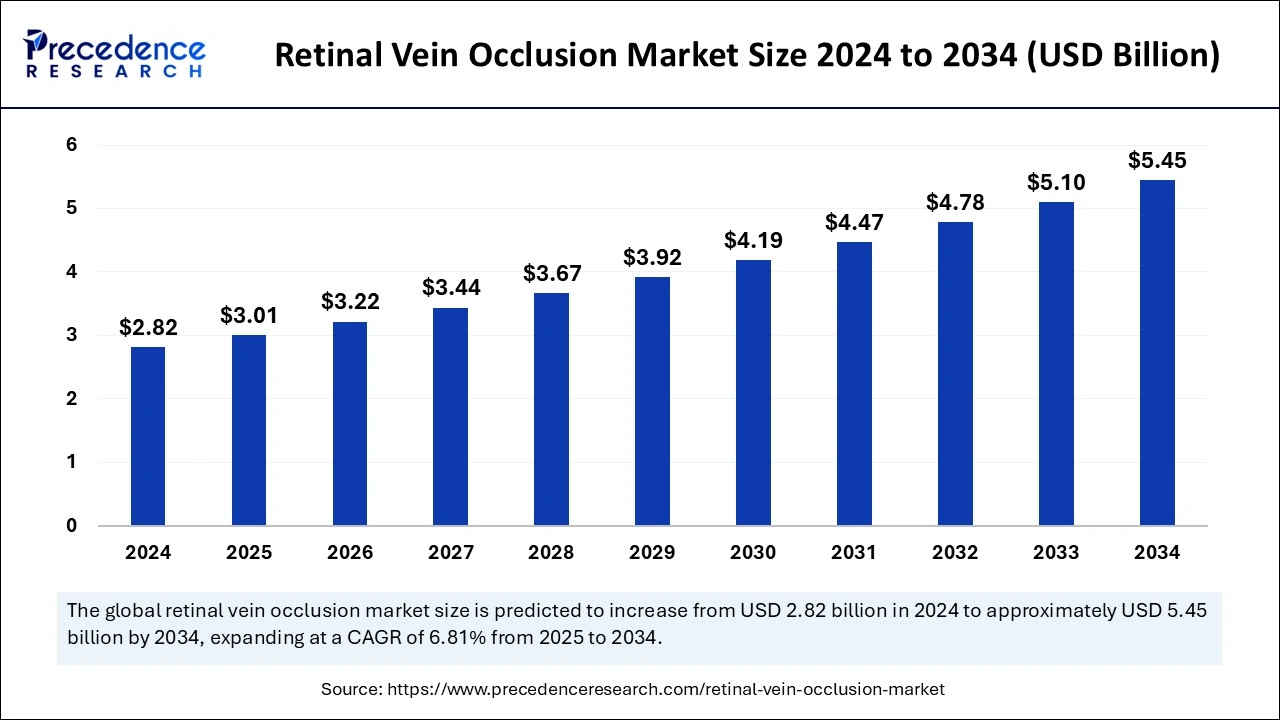
Artificial intelligence integration has improved the understanding and detection in the retinal vein occlusion market. AI is being seen as a tool to provide treatment options to the region or areas with limited access and less awareness. The adoption of deep learning has been beneficial in providing early disease diagnosis and management.
AI-enabled systems are able to detect diabetic retinal vein occlusion along with deep learning leverage. For example, AI-enabled systems such as the IDx-DR system, which is an FDA-cleared AI point-of-care screening system with 87% sensitivity, 90% specificity, and 96% imageability for more than mild DR, are able to detect referable diabetic retinopathy and decrease disparities in vision loss from diabetes.
The healthcare is being advanced to provide novel and efficient treatment solutions with the integration of AI and digital health tools, including teleophthalmology platforms. These tools not only help healthcare professionals to provide early diagnosis and understand the disease prevalence and related treatment but also enable them to reach underserved populations to enhance accessibility and availability of treatments. Moreover, the ability of AI algorithms to provide relevant and accurate data and answers to healthcare questions is drawing the attention of healthcare professionals as well as research institutes.
According to the cross-sectional survey of evaluated ChatGPT 4.0, it has the ability to provide responses to 130 questions, including medical retina and surgical retina topics, as per the American Academy of Ophthalmology’s Preferred Practice Pattern (PPP) guidelines.
The U.S. retinal vein occlusion market size was evaluated at USD 0.98 billion in 2024 and is projected to be worth around USD 1.93 billion by 2034, growing at a CAGR of 7.01% from 2025 to 2034.
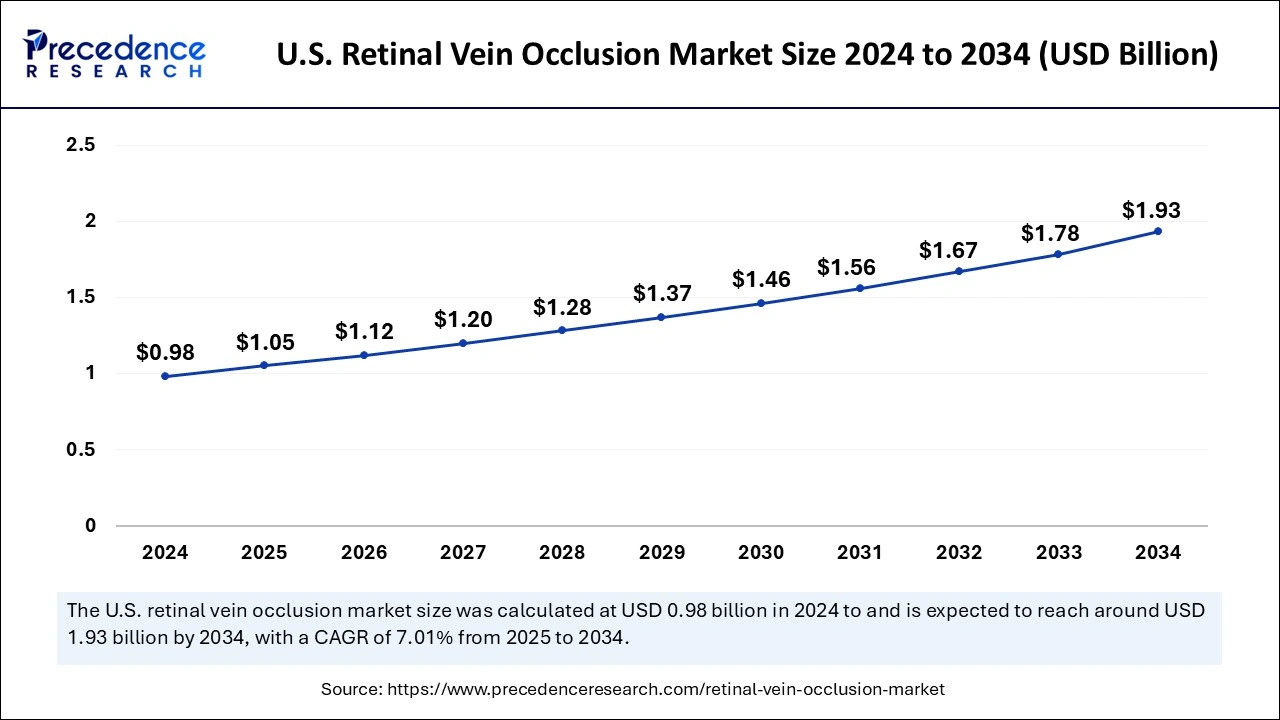
North America dominated the retinal vein occlusion market with the largest market share in 2024 due to the increased prevalence of eye-related issues in the region. The advanced healthcare infrastructure and presence of research institutes are leveraging the region to dominate the market. The United States is leading the regional market due to the presence of well-established healthcare and a competitive landscape in the country. The rising risk of diabetes and hypertension has contributed to the increased prevalence of RVO in the United States.
Regulatory bodies such as the FDA are persistent in providing approvals for innovative drugs and treatment solutions for people with RVO, making the country a leader in the regional market. Favorable reimbursement policies and government funding are contributing to the adoption of novel, innovative diagnostic tools and treatment solutions in the healthcare of the United States. With the growing focus of government and academic institutes on increased awareness and education of RVO, the United States is projected to continue to dominate the market.
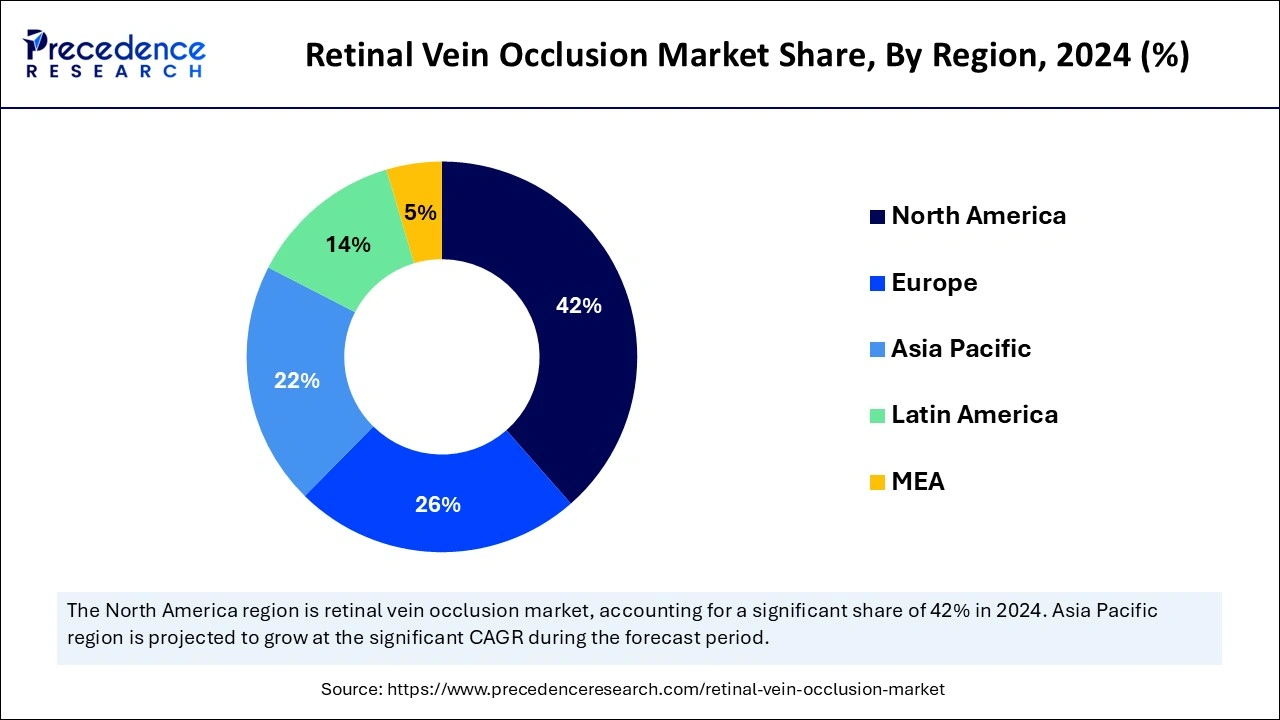
Asia Pacific is projected to expand at a notable CAGR in the retinal vein occlusion market during the forecast period. The expanding healthcare infrastructure and adoption of innovative technologies are driving the growth of the market in Asia Pacific. Additionally, the growing elderly population and the prevalence of RVO among them are contributing to the regional market growth. Countries like Japan, India, and China are contributing the highest share in the regional market growth.
India is leading the Asian retinal vein occlusion market due to the growing prevalence of RVO in the elderly population, well-established healthcare, and government funding for patients with eye-related issues. The government supports reducing the healthcare finance burden by leveraging the Indian market situation. Additionally, the growing accessibility of OTC drugs is contributing to this growth.
The government is a crucial player in the Indian market growth; government initiatives, including eye health camps, clinical quality assessments, and specialized training events to sensitize the project team, government departments, and hospital staff, are heightening the market expansion. Furthermore, the Rural Eye Health project is in collaboration with the government, highlighting a significant milestone for the states.
Rising issues of diabetes, hypertension, and atherosclerosis are the major factors driving the retinal vein occlusion market. The cases of macular edema and vision loss due to RVO are taking on top. The growing prevalence of RVO in the geriatric population. The rising demand for novel treatment solutions is the result of the increased prevalence of RVO and awareness among the public. The growing R&D activities for the development of innovative and advanced treatment solutions are leveraging the market. Additionally, growing regulatory approvals for new treatments are opening ways for market success.
The governments of these countries are determined to improve the awareness and education of eye-related issues among the population. The growing government funding for patients with eye-related issues is helping to overcome financial burdens and allowing access to advanced healthcare solutions. With rising government funding, policies are helping to enhance the awareness and education of retinal vein occlusion risks, which have contributed to increased demands for innovative treatment solutions, leading to fuel in market competition.
NEI introduced the National Eye Health Education Program (NEHEP) to improve the education of both professionals and the public about the importance of eye health in India, which includes more than 60 national organizations.
| Report Coverage | Details |
| Market Size by 2034 | USD 5.45 Billion |
| Market Size in 2025 | USD 3.01 Billion |
| Market Size by 2024 | USD 2.82 Billion |
| Market Growth Rate from 2025 to 2034 | CAGR of 6.81% |
| Leading Region | North America |
| Fastest Growing Market | Asia Pacific |
| Base Year | 2024 |
| Forecast Period | 2025 to 2034 |
| Segments Covered | Disease Type, Treatment Type, End-user, and Regions |
| Regions Covered | North America, Europe, Asia-Pacific, Latin America and Middle East & Africa |
Rising awareness
The increased prevalence of RVO, especially among elderly populations, has surged for increased awareness among healthcare professionals and patients in the retinal vein occlusion market. The prevalence of retinal vein occlusion has increased among the elderly population, which is the significant driving need for RVO treatment solutions. The education of RVo symptoms, risk factors, and treatment options is driving the market expansion. The academies and hospitals are playing a crucial role in this awareness. The rising awareness has led to demand for early diagnosis and advanced treatment solutions.
The increased demand has robustly increased the need for innovation and the development of novel treatments and drugs. A growing number of clinical trials has also been attributed. Additionally, rising demand has leveraged the requirement for regulatory approvals for innovative drugs and treatments. Government initiatives, including investments in research and development and programs for increased people's awareness and education of RVo, are playing a favorable role in the market growth.
High treatment cost
The high cost associated with treatments, including anti-VEGF, laser photocoagulation, and surgeries, is the major restraint of the global retinal vein occlusion market. The rising prevalence of RVO in the elderly population requires high-efficiency and advanced treatment solutions; however, the expenses of such treatment can hamper the market. The high treatment cost can restrain access and reduce acceptance of novel treatments. The rising healthcare financial burden is likely to hamper the adoption of advanced and innovative treatment options. However, rising government acceptance, investments, and funding for healthcare can help overcome such challenges.
Technology advancements
The market is witnessing several advancements in technologies that are making treatment more accessible and efficient for patients. Advancements in therapeutic technologies, including anti-VEGF therapies, laser photocoagulation, and gene therapies, are shifting the RVO market toward witnessing significant growth in the forecast period. Increased R&D activities are leading to such advancements. Anti-VEGF therapy advancements are allowing improved injectable medications; advancements in laser photocoagulation and focal laser treatments are enabling more effective and precise treatment solutions.
Advancements in gene therapies, including AAV vectors, are able to provide efficient treatments for RVO. Advancements in robot-assisted surgery, nanotechnology, and stem cell therapies are further merging the retinal vein occlusion market. Moreover, with the ongoing development of advanced technologies and therapies, the regulatory approvals are fueling the market share to be robust in the forecast period.
The central retinal vein occlusion (CRVO) segment accounted for the largest share of the retinal vein occlusion market in 2024. CRVO occurs in the main retinal vein. The rising prevalence of hypertension, diabetes, and atherosclerosis is leading to an increased risk of central retinal vein occlusion. The large prevalence of CRVO has increased the demand for novel and efficient treatment options; as a result, this segment is expected to grow. Ongoing research and developments for novel treatments and combination therapies are merging further expansion of the segment. Advancements in CRVO treatment solutions, including anti-VEGR and photocoagulation.
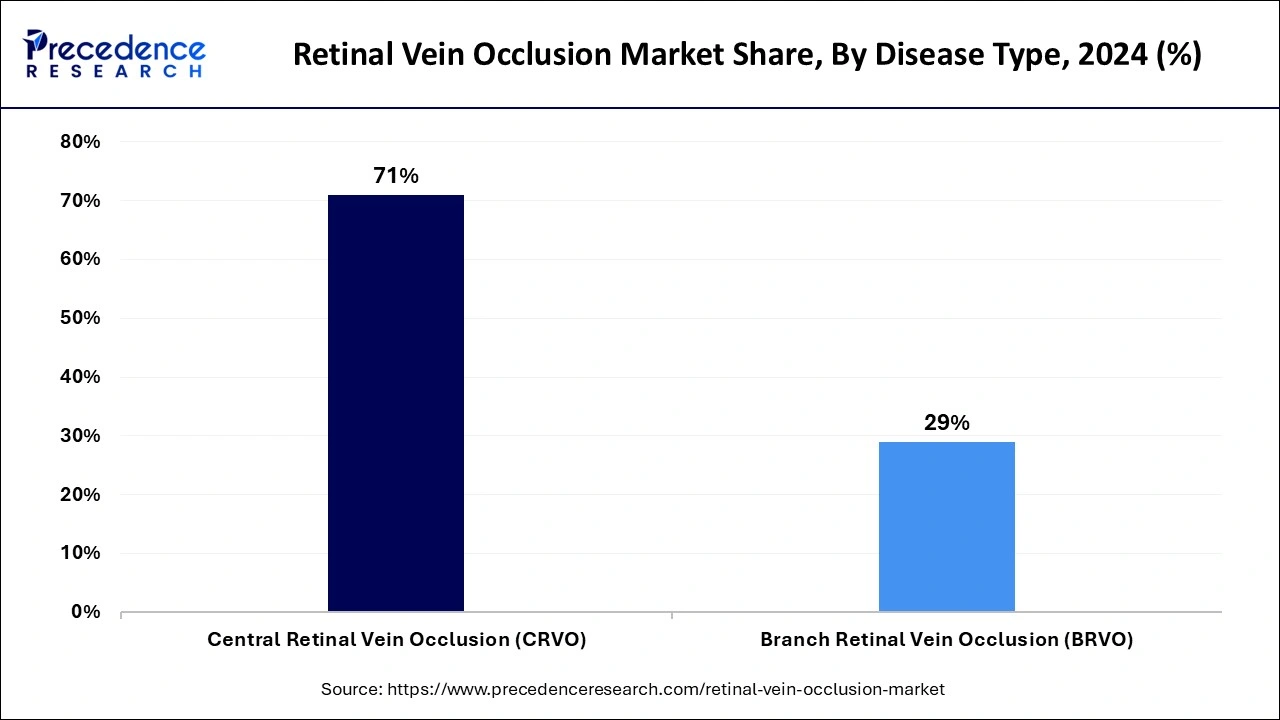
However, the branch retinal vein occlusion (BRVO) segment will witness rapid growth in the forecast period due to growing innovations and developments of novel treatment solutions. The rising focus on companies and research institutes for the development of innovative treatments for BRVO is driving the segment. BRVO is a common retinal disorder that occurs by blocking a small branch vein. The rising prevalence of BRVO and demand for early diagnosis and treatments has led to broad research and developments.
The anti-vascular endothelial growth factor (Anti-VEGF) segment generated the biggest retinal vein occlusion market share in 2024. The segment growth is accounted for majorly due to ongoing research and developments for anti-VEGF-based drugs and treatments, including aflibercept (Eylea) and ranibizumab (Lucentis). Additionally, the growing prevalence of age-related macular degeneration is fueling demands for anti-VEGF treatments. The rising focus of research institutes and companies on gaining regulatory approval is playing a favorable role in the segment's growth.
On the other hand, the corticosteroid drugs segment is projected to grow at a significant CAGR during the forecast period. Corticosteroid drugs are associated with improved vision and reduced risk of vision loss in RVO, inflammation, and edema associated with RVO. Corticosteroid drugs are easily available in hospitals as well as retail stores and in various administration forms, such as injectable, tablet, and topical eye drops, which make them majorly preferred by patients with RVO. The ability of corticosteroid drugs to reduce macular edema secondary to CRVO or BRVO is highlighting their popularity. Moreover, the availability of corticosteroid drugs in generic and branded options is a major driver of this segment.
The retail pharmacy segment dominated the global retinal vein occlusion market in 2024 due to the easy accessibility of drugs in retail pharmacy stores. Pharmacists are able to counsel patients properly, provide effective drugs, and educate patients regarding medication administration and management. Moreover, the affordability of treatments available in retail pharmacies attracts cost-effective conscious patients. The growing awareness and education have surged for the adoption of OTC (over-the-counter) treatment.
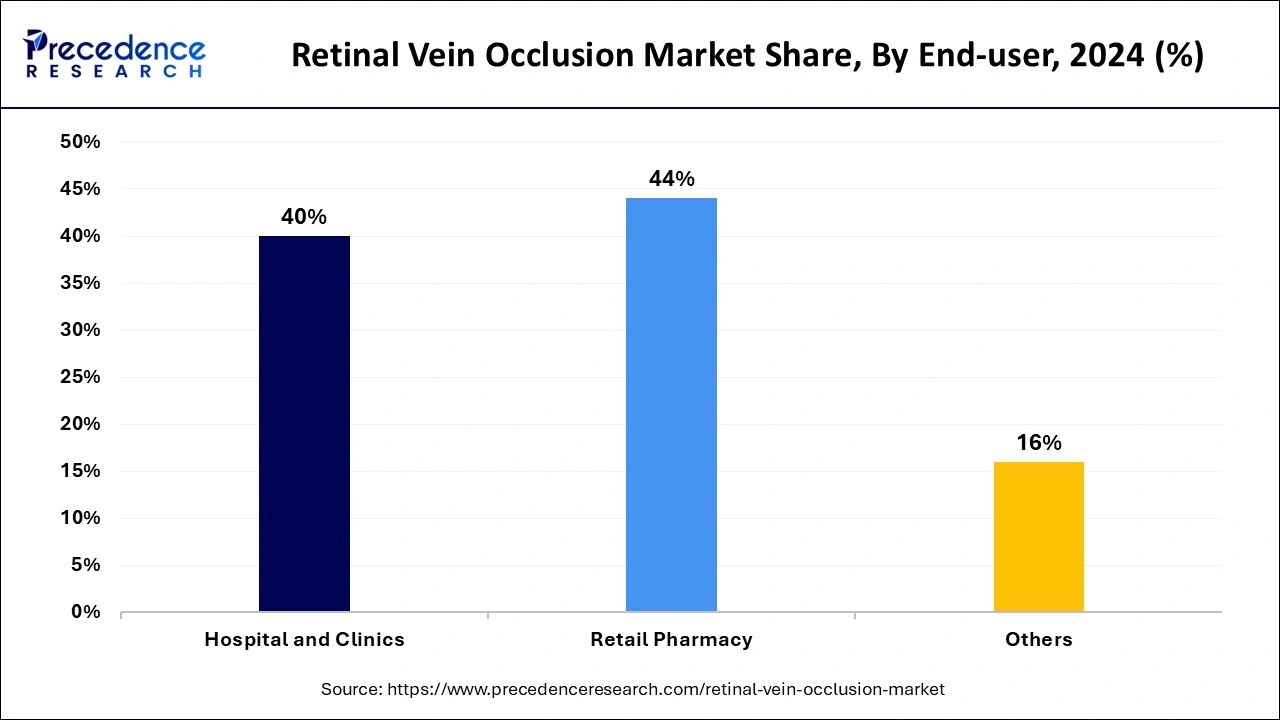
Additionally, the hospital and clinic segment is expected to grow rapidly in the forecast period due to rising patient admissions. The demand for early diagnosis is leveraging this admission rate. Additionally, increased RVO prevalence in the aging population has increased hospitalizations for better and more convenient care. The availability of healthcare professionals and advanced diagnostic equipment highlights the hospital and clinics segment.
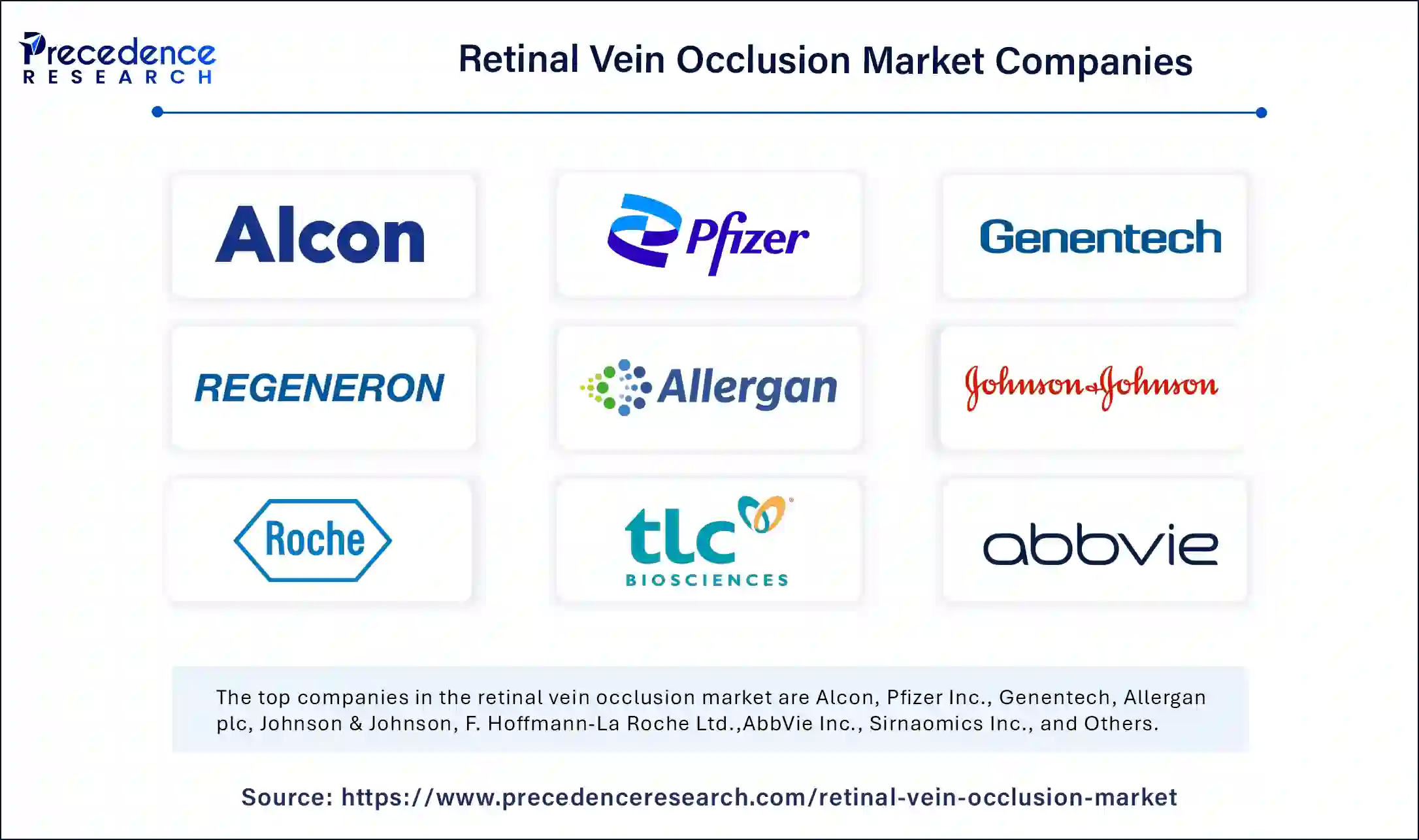
By Disease Type
By Treatment Type
By End-user
By Geography
For inquiries regarding discounts, bulk purchases, or customization requests, please contact us at sales@precedenceresearch.com
No cookie-cutter, only authentic analysis – take the 1st step to become a Precedence Research client
March 2025
October 2024
June 2024